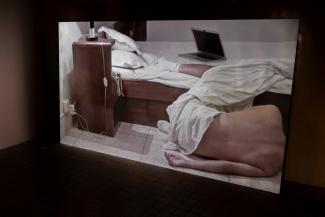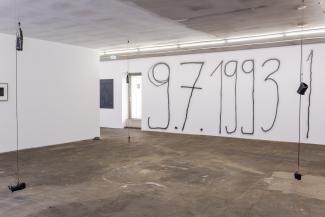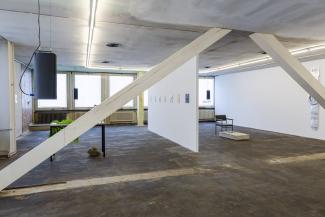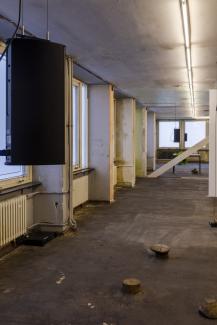The Axial Line
Exhibiting Artists: Christian Friedrich, Tatiana Trouvé, Karl Holmqvist and David Moser, Vajiko Chachkhiani, Dietrich Meyer, Alice Channer, Sophie Lee, Imran Perretta, Richard Frater, Shade Théret, Thomas Hirschhorn and Bob van der Wal.
Organized and Co-curated by Alexandra Symons Sutcliffe and Justin Polera, assisted by Ben Wegert and Alexander Swanson.
With the generous support of Till-Oliver Kalähne and Peter Obstfelder.
November 17th- December 6th
Opening: November 16th, Friday, 18:00-11:00
Performance: 19:30
In biology, the axial line is a hypothetical anatomical direction used to dissect a body or object. It is a geometric imposition on organic matter, an ordering system used to split and regulate the fragmentation of the body in scientific study. The flow of water through one’s system is axial, from mouth to anus and urethra, ingestion to excretion. The axis divides and expels, marking a position, direction, and the passage of time. It is a clinical and perverse impulse to split parts of the body from one another, to label, to reorder, and to re-compose. Analytic procedure renders human experience absurdly fractured, from which there is no possibility of return. One cannot recuperate wholeness.
An axis is also a distributive mechanism, voice and text as well as body and face. This exhibition brings together studies on paper, sculpture, ceramics, film, and a sound installation, each examining ways in which the body is marked and re-distributed through categorisation. Peeling away from direct representation of the body, The Axial Line seeks to dramatise the psychological effects of division and displacement and attempts to form new unities. In the exhibited works, the materials of the body are not just flesh and perishable matter, but also the attendant and mass-manufactured objects of everyday life, indexical impressions as well as waste products.
The Axial Line highlights the uncanny and absurd effects of the alienation of the body from itself and plays out (and with) attempts at self-composure; with the knowledge that the composed and re-composed body is a subject without innocence. Drawing on cultures of monumentalisation, philosophies of biopower, pedagogical experiences, and materialist discourse these artists deconstruct bodily representation and linear description. Deconstruction, in favour of a messier and more deeply-felt version of bodily experience, is not an analytic method, but a process of seeing parts and wholes together.
In der Biologie ist die axiale Linie eine hypothetische anatomische Richtung, die zur Präparation eines Körpers oder Objekts verwendet wird. Es handelt sich um eine geometrische Aufteilung der organischen Substanz, ein Ordnungssystem, mit dem die Fragmentierung des Körpers in wissenschaftlichen Studien gespalten und reguliert wird. Der Wasserfluss durch das System ist axial, vom Mund zum Anus und die Harnröhre sowohl als auch zur Aufnahme und Ausscheidung. Die Achse teilt und verlagert sich und markiert eine Position, Richtung und den Lauf der Zeit. Es ist ein klinischer und perverser Impuls, Teile des Körpers voneinander zu trennen, zu kennzeichnen, neu zu ordnen und neu zu komponieren. Das analytische Verfahren macht die menschliche Erfahrung absurd gebrochen, aus der es keine Möglichkeit der Rückkehr gibt. Man kann die Ganzheit nicht wiederherstellen.
Eine Achse ist auch ein Verteilungsmechanismus, Stimme und Text sowie Körper und Gesicht. Diese Ausstellung vereint Studien zu Papier, Skulptur, Keramik, Film und eine Klanginstallation, die jeweils untersuchen, wie der Körper durch Kategorisierung markiert und neu verteilt wird. Die Axiallinie löst sich von der direkten Repräsentation des Körpers und versucht, die psychologischen Auswirkungen von Teilung und Vertreibung zu dramatisieren und neue Einheiten zu bilden. In den ausgestellten Werken sind die Materialien des Körpers nicht nur Fleisch und verderbliche Materie, sondern auch die dazugehörigen und maßen gefertigten Alltagsgegenstände, Indeximpressionen sowie Abfallprodukte.
Die Axiallinie hebt die unheimlichen und absurden Auswirkungen der Entfremdung des Körpers von sich selbst hervor und spielt (und mit) Selbstgestaltung Versuchen aus; mit dem Wissen, dass der komponierte und neu komponierte Körper ein Subjekt ohne Unschuld ist. Ausgehend von Monumental Kulturen, Biopower Philosophien, pädagogischen Erfahrungen und materialistischen Diskurs dekonstruieren die Künstler die körperliche Repräsentation und lineare Beschreibung. Die Dekonstruktion zugunsten einer unordentlichen und tieferen Version der körperlichen Erfahrung ist keine analytische Methode, sondern ein Prozess, bei dem Teile und Ganzheiten zusammen betrachtet werden.
Text by Alexandra Symons Sutcliffe
Image: The Axial Line, Installation view. Works by Richard Frater, Tatiana Trouvé, and Vajiko Chachkhiani
Still from performance by Shade Théret at exhibition opening,
I don’t believe you know me, although you know my name.
You can find me by the orange trash can between the arched lamp and the square windows.
You can look behind the square windows.
You can find me between the arched lamp and the square windows.

Imran Perretta
still from DESH, 2016
8min digital film, colour and sound
16:9 ratio projection
Edition of 5 + 2 AP
Richard Frater
Not yet titled, 2017
Ambrotype (collodian positive print on glass)
20 cm x 14 cm
Document of commissioned souvenir ring by Jens Hansen (official ringmaker for The Lord of the Rings) with personal engraving; 2015; constructed from silver residue extract from processed 16 mm film, footage shot in Wellington in 2011
Courtesy of the Artist











